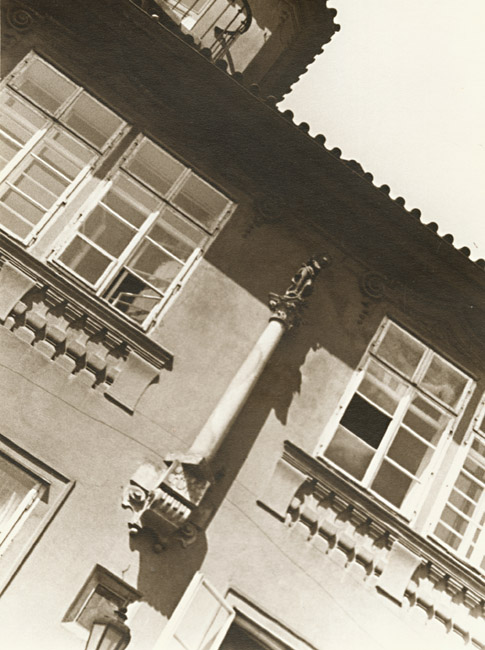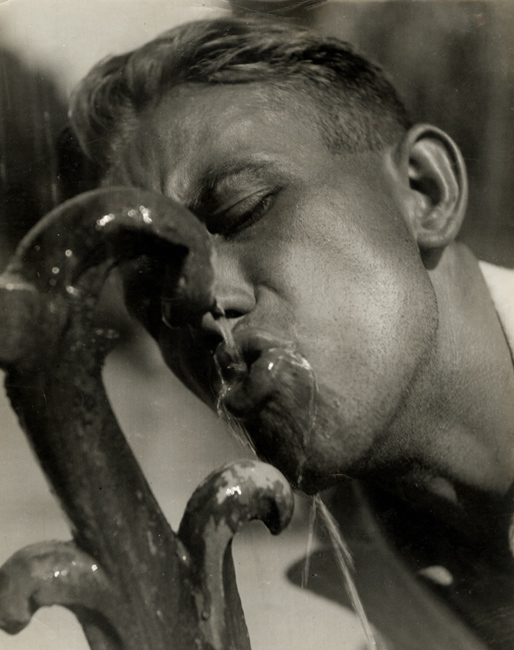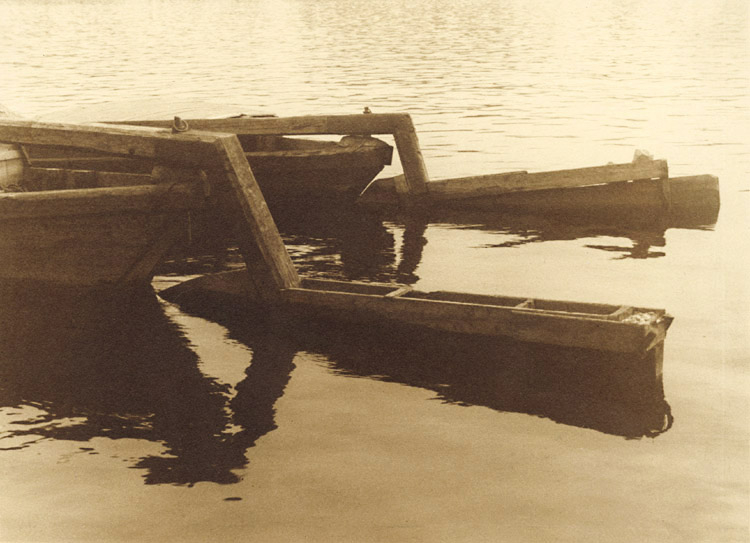
Funke - Three Children Playing in the Dirt
At the turn of the century, the new spirit of the age, or Jugendstil, was being expressed in the visual style of Art Nouveau. This style was successful in merging modern technology with flowing organic forms reminiscent of the pre-industrial natural world. Before World War I many young Czech artists traveled to Western Europe to study under proponents of Art Nouveau and to experience the charged environment of change.
Alfonse Mucha, a painter and photographer studied in Paris and produced quintessential Art Nouveau fine art, as well as commercial art in the form of stunning advertising posters. As many artists before and after him, Mucha used photography to aid in his paintings and prints.
Frantisek Drtikol was another Art Nouveau artist trained as a painter and photographer in Munich. Mucha and Drtikol brought back to Prague the fin de siècle view of modern art and incorporated technical proficiency and aesthetic fluidity into the work they produced in the early years of the 20th century.

Drtikol - Nude Study
In 1918, at the end of WWI, Czechoslovakia gained independence from the Austro-Hungarian Empire. In the post-war euphoria a new generation of Czech fine art photographers looked beyond its borders to forge links with the flourishing avant-garde and modernist movements of Art Nouveau, Dada and Surrealism in Western Europe. This new generation of photographers set the direction of modern photographic practices and trends between the wars and beyond.
The 1920s were critical years for the development of modern Czech fine art photography. There was a radical shift away from sentimental Pictorialism as practiced by members of the many amateur photo clubs toward avant-garde and modernist practices and 'straight' or 'pure' photography as advocated by Dr. Drahomir Josef Ruzicka. Dr. Ruzicka, a Czech American, appeared on the scene with issues of Stieglitz's Camera Work tucked under his arm along with photographs by other Photo-Secessionists, who had taken a decidedly modern turn.
Josef Sudek, Jaromir Funke and Adolf Schneeberger became Prague's secessionists when they were expelled from the Fotoklub of Prague for vociferously protesting against the club's amateur provincialism. They founded the Czech Society of Photography, taking up the banner of 'professional' and leaving the title of 'amateur' to a previous generation, in a previous century. The trio saw a major role for the medium of photography in shaping a new and modern society, and so literally put the medium to work in this pursuit. Other Czechs were soon to follow.
Frantisek Drtikol, who already had a successful portrait studio in Prague, hired the 15-year old Jaroslav Rossler as an apprentice. Bohumil Stastny was regularly producing editorial and advertising photography for Weekly Variety (Pestry tyden) Prague's leading picture magazine. Jan Lauschmann, was publishing both his modernist urban photographs and theoretical writing on photography. Miroslav Hak trained in his father's photographic studio in Bratislav and then came to Prague to begin his professional career.
As for the original trio, Schneeberger made his mark as an art director and editor. Funke's tremendous influence was delivered via his avant-garde magazine ReD, where he published edgy and dark modernist work along with strong commentary promoting Modernism in the field. Sudek opened his own commercial studio near the Prague Castle, where he worked in advertising, portraiture and the reproductions of art works. He also produced the now famous series of photographs of St. Vitus Cathedral for the publishing house Cooperative Work.
Art and photography had a palpable relationship to life in between-the-wars Czechoslovakia. In 1923 the intellectual and creative powerhouse Karel Teige formed the avant-garde Art Union Devetsil. The artist members promoted modern culture for a modern society. Devetsil artists worked in journalism, theater production, set design, illustration, advertising and publishing--in other words, all media that shaped and defined popular culture.
Jaroslav Rossler was only 19 years old when he was invited to join Devetsil. Rossler was shy and worked well when he worked alone. His advertising and illustration photography won him acclaim, but his personal work fused a strong technical prowess with an aesthetic drive deeply rooted in Surrealism and Constructivism. Rossler soon explored the concepts of montage, collage, and camera-less images. He became the preeminent avant-garde master of incongruous imagery that seemed to communicate states of mind or reflections of a brooding soul.
Influenced by the work of Man Ray and Laszlo Moholy-Nagy, he was later to move to Paris where he would continue his artistic work while creating advertising images for the likes of the Michelin and Shell corporations.
Jindrich Strysky, also a member of Devetsil, worked as a journalist and was the director of design for the Liberated Theater. His personal work focused on the realm of the surrealistic poetic document. He was a genius in this mode of photography where coincidental and everyday object are raised to a new level of symbolism. For Strysky photography was the perfect medium to extract dream-like visions from reality where the two would then become strange bedfellows.
Frantisek Drtikol's work also changed during this period becoming more abstract and mystical with his spirited figure and shadow studies. There is a stylistic link between his dark vision of woman as 'femme fatale' and his professional portraits of the great dancers and theater actresses in their roles as Salome and Cleopatra.
This is also an era of unprecedented photographic exhibitions. D.J. Ruzicka organized exhibitions of American Photo-Secessionists, including Clarence White, at the Czech Society of Photography in Prague, and also held solo shows of his own work.
Czech photographers exhibited in the famous international Film and Foto show in Stuttgart. The Syndicate of Visual Arts at Manes was quick to open a photograph section (actually founded by Sudek and Tibor Honty among others) and began to regularly exhibit the work of the best of Prague's new generation of modern photographers.
Miroslav Hak--with some prompting by Funke--had his first solo exhibition of photographs at Manes. He was also included in Manes First International Photography Exhibition.
In 1926 Rossler and Man Ray held a joint exhibition of their surrealist work at the 3rd Annual Devetsil Exhibition.
When the Germans marched in to occupy Czechoslovakia it was like a storm cloud casting its dark shadow. Many photographers' activities were shut down. Funke who had begun to teach at the State Graphic Arts School in 1935 continued to influence students and his colleagues. He continued to publish his politically controversial writings on modern photography and culture, but these were dangerous times for artists. For his views, Funke ended up spending a period of time in a labor camp.
Styrsky distributed his collection of photographs in a book entitled, On the Needles of These Days, that was a self-published underground publication.
Sudek gave up his commercial practice and retreated to his studio to photograph quiet, intimate, and dark images. From this period on he worked only on personal projects. From My Studio Window, Labyrinths, Remembrances, and Rothmayer's Magic Garden are just a few of the many series he produced.
Rossler maintained a commercial studio in Prague, but gave up his personal photography until years after the war.
Younger photographers like Vilem Reichmann and Hak took positions as war documentary photographers. During this period Reichmann produced his Wounded City series and in the same vein Miroslav Hak captured the lurking fear in the enemy occupied city.
It is on the shoulders of this first and celebrated generation of Czech photographers that all future generations must stand. The poetic document and surreal imagery of these pioneers are embedded in the work of such contemporary greats as Josef Koudelka, Jan Saudek, Jan Lukas, Ladislav Postupa and Vaclav Jirasek.
Even though each generation has their own unique vision, they must contend with the ideas and images of those that have gone before them prior to embarking on new horizons.
Exhibited and Sold By
Contemporary Works / Vintage Works, Ltd.
258 Inverness Circle
Chalfont, Pennsylvania 18914 USA
Contact Alex Novak and Marthe Smith
Email info@vintageworks.net
Phone +1-215-518-6962
Call for an Appointment











Share This